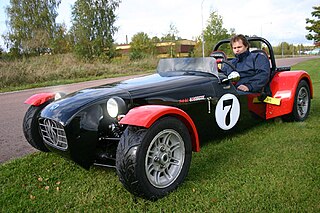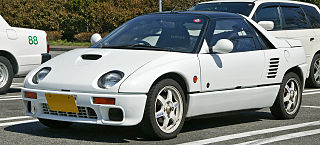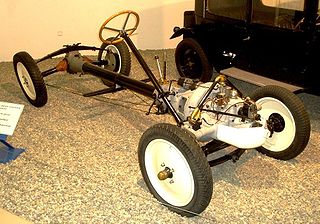
A Locost is a home-built car inspired by the Lotus Seven. The car features a space frame chassis usually welded together from mild steel 1 in × 1 in square tubing. Front suspension is usually double wishbone with coil spring struts. The rear is traditionally live axle, but has many variants including independent rear suspension or De Dion tube. Body panels are usually fiberglass nose and wings and aluminium side panels. Each car is highly individualized according to the resources, needs and desires of each respective builder.

The Lotus Seven is a small, simple, lightweight two-seater open-top sports car produced by the British manufacturer Lotus Cars between 1957 and 1972.

Vauxhall Motors Limited is a British car manufacturer based in Chalton, Bedfordshire, England, a sister brand of Opel and since January 2021 a part of Stellantis.

The Ford Focus is a compact car manufactured by the Ford Motor Company and created under Alexander Trotman's Ford 2000 plan, which aimed to globalize model development and sell one compact vehicle worldwide. The original Focus was primarily designed by Ford of Europe's German and British teams.

The MK Indy is a Lotus 7 replica based on the Locost principle, built by MK Sportscars in Maltby, Rotherham. The Indy has an independent rear suspension using the differential and drive shafts from a Ford Sierra. It uses many other components from the Sierra, including front hubs and steering rack. Further, it can be fitted with any of a variety of engines, the most popular choices being the Ford Pinto engine from the Sierra for its ease and cheapness or a large motorcycle engine for its light weight and high rpm.

The Renault Laguna is a large family car by European standards, and was marketed by the French manufacturer Renault from 1994 to 2015. The first Laguna was launched in 1994, the second generation was launched in 2000, and the third generation was launched in October 2007.

A car platform is a shared set of common design, engineering, and production efforts, as well as major components over a number of outwardly distinct models and even types of cars, often from different, but somewhat related marques. It is practiced in the automotive industry to reduce the costs associated with the development of products by basing those products on a smaller number of platforms. This further allows companies to create distinct models from a design perspective on similar underpinnings.

The Batmobile is the fictional car driven by the vigilante Batman. Housed in the Batcave, which it accesses through a hidden entrance, the Batmobile is both a heavily armored tactical assault vehicle and a personalized custom-built pursuit and capture vehicle that is used by Batman in his fight against crime. Using the latest civilian performance technology, coupled with prototype military-grade hardware—most of which was developed by Wayne Enterprises—Batman creates an imposing hybrid monster to prowl the streets of Gotham City.

A notchback is a category of car characterized as having a three-box design where the trunk (boot) volume is less pronounced than the engine and passenger compartments.

The Autozam AZ-1, known by the framecode PG6SA, is a mid-engined kei-class sports car, designed and manufactured by Mazda under its Autozam brand. Suzuki provided the engine.

A gull-wing door, also known as a falcon-wing door or an up-door, is an automotive industry term describing car doors that are hinged at the roof rather than the side, as pioneered by the 1952 Mercedes-Benz 300SL race car (W194) and its road-legal version (W198) introduced in 1954.

The Honda Beat is a rear wheel drive, mid-engined two-seat roadster kei car produced from May 1991 to February 1996. The Beat was the last car to be approved by Soichiro Honda before he died in 1991. The total number of cars produced was around 33,600. Most of the production occurred in the first year, and then production and sales fell drastically. The design of the car originated from Pininfarina, who then sold the design plan to Honda. The Beat was one of many cars designed to take advantage of Japan's tax-efficient kei car class.
A motorcycle's suspension serves a dual purpose: contributing to the vehicle's handling and braking, and providing safety and comfort by keeping the vehicle's passengers comfortably isolated from road noise, bumps and vibrations.
Sylva Autokits is a kit car manufacturer based in Lincolnshire, England. Sylva was founded in 1981 by Jeremy Phillips and has developed and produced a number of small and lightweight sports cars. Sylva cars have won a number of 750 Motor Club Kit Car championships.

Backbone tube chassis is a type of automobile construction chassis that is similar to the body-on-frame design. Instead of a two-dimensional ladder-type structure, it consists of a strong tubular backbone that connects the front and rear suspension attachment areas. A body is then placed on this structure. It was first used in the English Rover 8hp of 1904 and then the French Simplicia automobile in 1909.

Marc Nordon Racing is a kit car manufacturer specialising in bike engined cars or BECs and in particular, Lotus Seven Replicas. They are based in Harrogate, England.
750 Motor Club is a motor racing club in the UK. It was founded in 1939 to promote the sporting use of the Austin 7. '750' refers to the near-750cc Austin 7 engine. It later led to racing and the 750 Formula where specials are raced. Famous members include Colin Chapman, Eric Broadley, Adrian Reynard, Arthur Mallock, Derek Bennett, Tony Southgate, Brian Hart, Gordon Murray, Jem Marsh, Frank Costin and Mike Pilbeam. These engineers and designers produced the first Lotus, Lola, Chevron, Speedex, Marcos, Pilbeam and other sports and racing cars between the 1940s and 1960s.

The Ferrari 458 Italia is a mid-engine sports car produced by the Italian automobile manufacturer Ferrari. The 458 replaced the F430, and was first officially unveiled at the 2009 Frankfurt Motor Show. It was succeeded by the 488 GTB, which was unveiled at the 2015 Geneva Motor Show.

Haynes Roadster is a replica of Lotus Seven home-built according to a book Build Your Own Sports Car: On a Budget by Chris Gibbs (ISBN 1-84425-391-0). Ford Sierra is used in the car as a donor for drivetrain and suspension components.
Aries MotorSport is a British kit car manufacturer based in Cardiff South Wales. The company was created in April 2007 and is the distributor of the Stuart Taylor Locost and LocoBlade kits. These are Lotus Seven replicas based either in car or bike engines.















